- What is Raja Yoga?
- Ashtanga vs. Raja Yoga
- Yoga of Mind
- Raja Yoga Meditation Practice
- Benefits
- Books for further reading
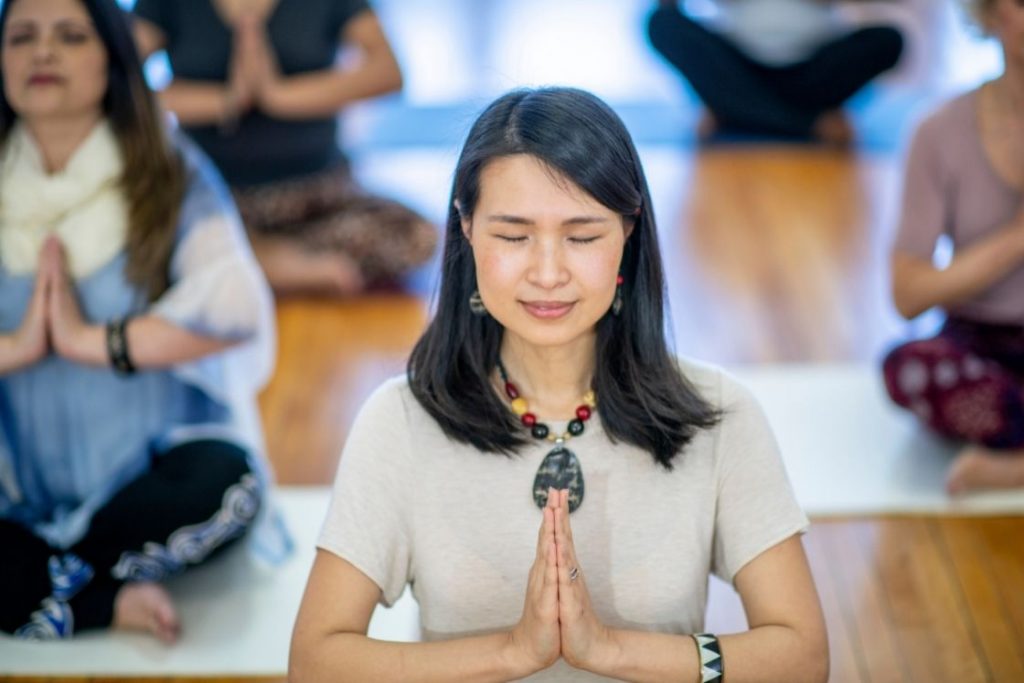
Though yoga is often seen as a form of exercise through which one can achieve spiritual and mental well-being, some yoga forms concentrate on mental practices.
The four paths of yoga comprise of such practices that will lead the practitioner on the path of self-realization and leads to Moksha (salvation). Each of these four paths is closely interlinked.
In this article, one of these four paths, Raja Yoga, will be detailed.
What is Raja Yoga?
The Sanskrit word raja means king or royal. It is the King of Yogas. Raja yoga focuses on attaining enlightenment through meditation and energetics. In this form of yoga, the yogi sits in a meditative pose and silences their mind by restraining the wayward thoughts, and eventually enters into a thoughtless state.
Swami Swatmarma in Hatha Yoga Pradipika says the aim of Hatha Yoga (physical form of yoga) is to attain Raja Yoga. It means the asanas and pranayama we practice have the ultimate purpose to build a foundation for raja yoga practice.
Raja Yoga follows a dualistic philosophy of differentiating the self from the absolute reality, however, it eventually makes the yogi take the path of self-realization. By working through the mind, the practice of Raja Yoga paves a way to discipline, self-control, concentration, mental peace, and inner joy. It is a unique form of yoga where one doesn’t need any mantras or rituals to be followed and can be practised anytime and anywhere.
Raja Yoga was popularized by Swami Vivekananda who put it at par with Patanjali’s Yoga Sutras. It is noteworthy to mention here that Raja Yoga has been mentioned in the Bhagavad Gita as one of the paths to enlightenment but has been used as another name for enlightenment. But over time, with the efforts of some notable scholars, Raja Yoga got recognition as a separate path and is now counted as one of the 4 paths of yoga.
Is there a difference between Ashtanga Yoga and Raja Yoga?
Ideally, there is no difference between Ashtanga Yoga and Raja Yoga and they can be used interchangeably. The concept of Raja Yoga follows the principles of eight-limb yoga or Ashtanga Yoga that was compiled by Patanjali. By practising the eight-limb yoga, the practitioner can reach the enlightened state of consciousness or samadhi.
The following are the eight limbs of Raja Yoga:
- Yamas (self-control or restraints) – ahimsa (non-violence), satya (truthfulness) asteya (non-stealing), brahmacharya (chastity) and aparigraha (non-possessiveness).
- Niyamas (discipline or observance) – saucha (purity), santosha (contentment), tapas (self-discipline), svadhyaya (self-study), ishvarapranidhana (devotion or surrender).
- Asana (physical poses or exercise)
- Pranayama (controlled breathing exercise)
- Pratyahara (sense withdrawal from external objects)
- Dharana (concentration)
- Dhyana (meditation)
- Samadhi (complete realization or super consciousness)
This eight-limbed approach is a systematic method to find liberation from all sufferings.
Raja Yoga as the Yoga of Mind

Raja yoga is mainly concerned with following a path of self-discipline and practice. Just like how a king acts independently, with self-confidence and assurance, in the same way, practising Raja Yoga will make the practitioner autonomous, independent and fearless.
This ancient system of meditation helps us achieve a higher state of consciousness by bringing back the state of inner peace and reviving the good qualities and virtues inside us. You are adopting methods to control your mind and opening it to find self-awareness, true peace, and happiness.
With a calm and controlled mind, you will have a good relationship, will do the right things, and focus on correcting the self rather than others; fostering healthy mental well-being. Your body will automatically relax and your focus will be on the mind rather than the matter. You will see a shift in the way you view yourself and have a deep understanding of the connection between the Self and the Supreme Power.
The 5 stages of Mind
Since Raja Yoga involves using the mind, practising one-pointed concentration (Dharna) is an essential premise before starting the Raja Yoga meditation. Holding one thought for a longer period will not only strengthen the mind but will make the mind one-pointed. The fewer the thoughts, the more peace you will have.
In Patanjali’s yoga sutra, the mind is said to move through 5 states in general. These are;
- Kshipta – the mind is in a scattered state
- Mudha – the dull and forgetful state of mind
- Vikshipta – concentrated yet a mildly scattered state of mind
- Ekagra – prolonged practice makes the mind one-pointed; focused or meditative state of mind
- Niruddha – fully controlled state of mind
These 5 stages are called Chitta Bhumis. The mind is said to happen in yoga only in the state of Ekagra and Niruddha.
How to practice Raja Yoga Meditation?
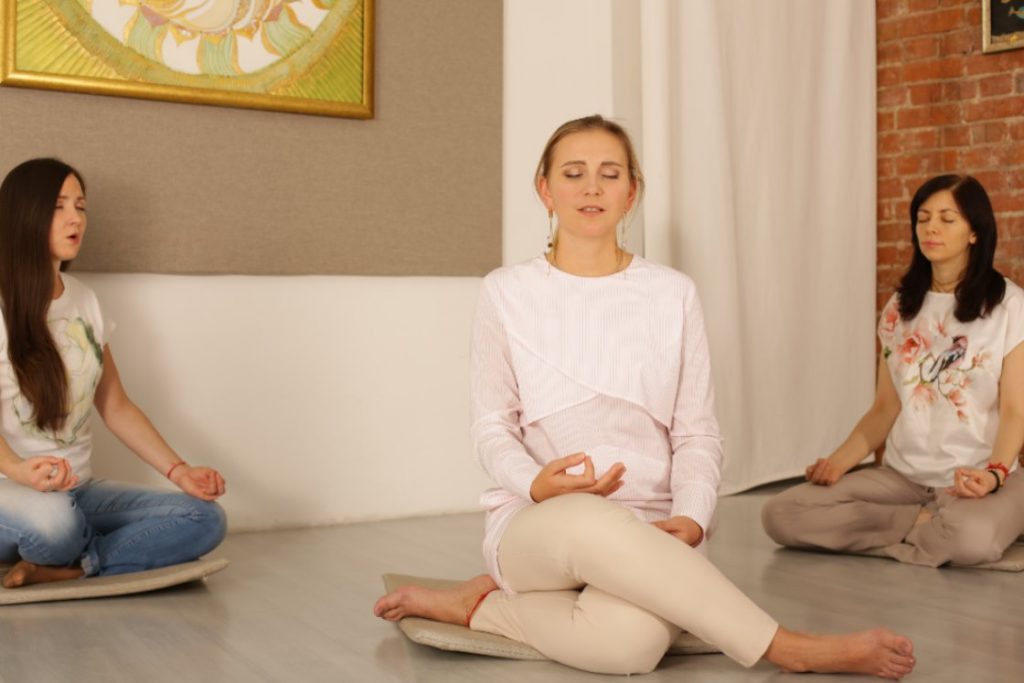
Raja yoga meditation is not much different from any other meditation style. You meditate with open eyes while engaging your mind to experience inner peace and freedom. The unique Raja Yoga meditation technique will make your mind your best friend, change your viewpoint, and help you better connect your ‘self’ to the higher power.
Here are the steps of Raja Yoga Meditation.
1. Locate a peaceful space
Meditation is best done in a calm and peaceful environment. It can be a room in your house, your garden, or your backyard, a place with no distractions will be beneficial. Also, it is recommended that you practice meditation at dawn when the noise is less and the air is fresh. The peace and tranquility will help you throughout the day.
2. Sit in a comfortable position
A position where you can relax and it for a longer duration is of utmost importance. If you’re uncomfortable, your meditation practice will be hampered frequently and your mind will not be able to concentrate. Sitting crossed-leg on the ground is the best way to get into a meditative state.
You can also use a rolled blanket or a cushion to support your posture or if need be, sit on a chair. The ultimate goal is to feel stable and comfortable to carry on with the meditation without constant fidgeting.
3. Bring your mind to the present
While most meditation is done with closed eyes, Raja Yoga instructs you to open your eyes and concentrate on a focal point. You can focus on a vase, a pen stand, a flower, a strand of grass, a drawing on the wall, or a candle flame. By focusing, you will slowly be able to withdraw your senses from everything around you. You will be either focusing on your breathing rhythm or the chosen focal point.
4. Channelize your thoughts
When you are building your concentration, you will have multiple thoughts running around your mind, which is a natural process of the brain. You should not put effort into reflecting on them, rather acknowledge them and let them pass. Each time a thought comes up, let them pass and come back to your point of focus. Here, patience is the key!
5. Pick a positive thought
In the myriad of thoughts that are coming up, you need to create a peaceful thought on which you can meditate. The thought can either be related to a situation you are currently facing or a general thought that will instill positivity. For example ‘I am a peaceful soul’, ‘I will not let my worry control me’ or ‘I am happy with my life’ etc.
You will slowly start to notice that this thought is making you feel refreshed and radiating through your entire being. It will ultimately lead to the path of understanding and realization. You may still face the onslaught of a few distracting thoughts, but you should let them pass and continue meditating on your positive thought.
6. Keep the feeling of peace
Once you have finished the meditation, maintain the peaceful feeling you gained from the positive thought. As you go through your day with that tranquility, you will find it easy to overcome any situation or challenge. And if at any point in time you feel like you are losing your peaceful state, take out some time to again meditate on a positive thought.
You can start by practicing this meditation technique for at least 20 minutes a day. However, this time frame doesn’t mean that you should rush with it. Meditation is very subjective and different people will take different time to adjust. Have the patience to build your mental strength.
Benefits of Raja Yoga Meditation
1. Reduces stress and anxiety
Other forms of yoga mostly deal with controlled breathing exercises for better mental well-being whereas Raja Yoga deals with managing and controlling the mind. When the mind is in a state of calmness, you will be in better control of your emotions and thoughts. You will be able to control your outburst and reaction in stressful situations.
2. Diminishes negative habits
The Raja Yoga meditation invokes positive qualities like happiness, bliss, knowledge, peace, love, calmness, and power. The positivity will encourage the mind to think in the right direction and remove negative thoughts and patterns from the inside. With everything going in the right direction, the negative habits will automatically be eradicated from your life.
3. The mind becomes clear and focused
When practicing Raja Yoga meditation, you are required to let go of the distracting thoughts and encourage sitting in silence. By removing the clutter in the mind, you can have clarity of mind and become more focused in life. It also helps with finding the reason and purpose of life.
4. Increased memory and concentration
When you stay in the present, you are essentially helping yourself in enhancing your memory and concentration. Raja Yoga meditation encourages you to stay in the present by practicing open-eye meditation and focusing on a particular point. The mind’s one-pointedness aids in adding value to the work and provides us with a better result.
5. Improved quality of sleep
You tend to lose sleep when your mind is in chaos or you are experiencing anxiety or stress. Through Raja Yoga meditation, you are training your mind to think positively and focus on the right thoughts. This helps in calming your mind and clearing negative thoughts and improving the quality of sleep.
Conclusion
With the help of Raja Yoga, you will learn to appreciate the silence and learn how to live with respect, dignity, and trust. Even though it is a complex form of yoga, in its essence it is a form of union of the mind-body-soul. It is a reminder that we are one with the Supreme Power and Raja Yoga is the way to purify our mind and soul to bring forth the beauty and divinity of the Self.
Books on Raja Yoga for Further Reading
1. Raja Yoga by Swami Vivekananda – This book is one of the most acclaimed for propagating Raja Yoga to the general audience, especially to the western audience. It was published in July 1896.
The book contains the transcriptions of lectures and translations and commentaries of Yoga Sutras by Patanjali. This book highlights the techniques to control your mind and the steps to channelize your thoughts and energies towards self-realization.
2. The Art and Science of Raja Yoga by Swami Kriyananda – This book contains 14 lessons on the application of Raja Yoga to reach one’s spiritual destiny. These 14 lessons are the talks given by Swami Kriyananda that contain profound teachings and detailed techniques that provide a deep understanding of the spiritual path one can take.
3. The Yoga Sutras of Patanjali commentary by Swami Satchidananda – If one wants to learn about Raja Yoga in a relatable and practical way, this foundational book is the one you are looking for. Swami Satchidananda has very effectively translated the famous Yoga Sutras through which the reader will be able to understand the importance of the physical as well as the mental postures of yoga.
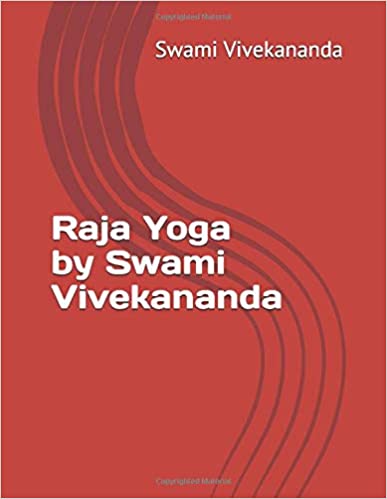
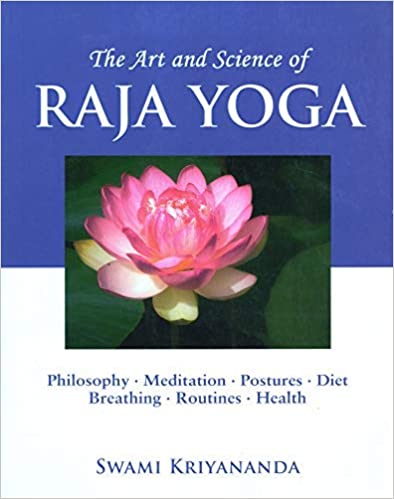
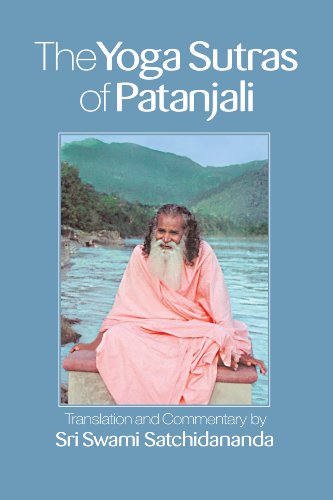





I found this blog post on Raja Yoga incredibly insightful! The breakdown of its meaning and the meditation practices provided practical guidance for my own journey. I especially appreciated the section on the benefits—it’s inspiring to see how this ancient practice can still have a positive impact on our modern lives. Looking forward to incorporating these techniques into my routine! Thank you for sharing!